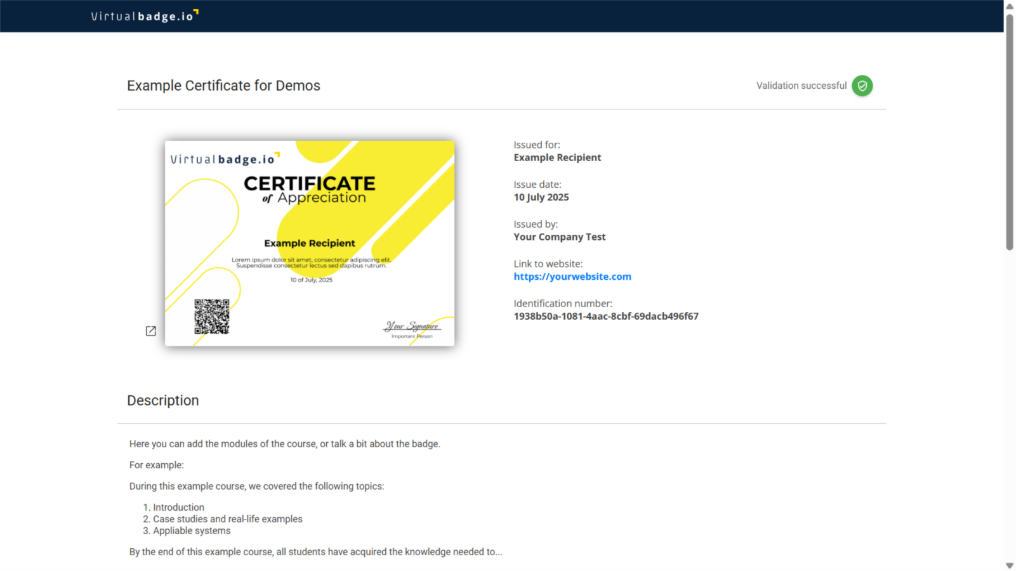No user accounts required for your recipients -
Existing certificates and badges always stay valid


How to safeguard the trustworthiness of digital credentials in an era of generative AI and deep-fake threats



Artificial intelligence is reshaping how information and identities are created online. Tools like ChatGPT or DALL·E can now generate text, images, and even official-looking documents in seconds. What once required expertise can now be faked with a few clicks.
For education providers and training institutions, this raises a critical question: how can trust in digital certificates be preserved when AI can imitate almost anything?
Key points to note:
In a world where artificial intelligence can fabricate reality, authenticity becomes the most valuable asset a certificate can hold.
Authenticity defines the value of every certificate and badge. A digital credential is more than proof of participation. It is a public statement of achievement and a reflection of the issuing institution’s credibility. When authenticity is missing, both learners and organizations lose trust.
For education and training providers, maintaining authenticity ensures that every certificate represents verified performance. It protects the learner’s reputation and strengthens the issuer’s brand.
Key reasons why authenticity is essential:
The article: The Problem of Fake Certificates in Germany highlights how fake certificates are spreading quickly in Germany. Many look genuine but are completely fabricated. This trend shows why traditional PDFs or static files are no longer enough.
Modern solutions solve this by
Authenticity transforms a simple digital document into a trusted digital asset.

Generative AI is making document forgery easier, faster, and harder to detect. Advanced algorithms can now imitate official layouts, create realistic signatures, and even generate fake validation URLs. These capabilities pose a direct threat to digital certification.
The most common risks include:
The consequences are serious. Employers may unknowingly validate unqualified candidates, while educational institutions risk damage to their credibility. The trust that once relied on visual authenticity now requires technological verification.
To counter these risks, issuers need:
Artificial intelligence will continue to evolve, but so can the methods of protecting authenticity. The solution lies in combining technology with transparency, ensuring that every credential tells the truth behind the achievement.
The increasing risks of AI-driven forgery demand modern protection methods. Visual design alone can no longer guarantee authenticity. Educational providers need technology that verifies certificates automatically and transparently.
Digital verification solutions make this possible. Instead of static PDFs, verifiable digital certificates combine secure storage, validation tools, and transparent data tracking.
Key strategies include:
Leading providers also follow international standards such as Open Badges or W3C Verifiable Credentials, which define clear rules for digital trust.
For a deeper understanding of how to move from PDFs to secure verification, see Digitizing Certificates – The Comprehensive Guide 2025. It outlines how modern verification technologies strengthen trust and simplify digital administration.
Protecting authenticity is not only a technical challenge but also an operational one. Educational providers need structured processes that ensure every certificate issued reflects verified learning outcomes.
Effective best practices include:
Organizations that adopt these practices not only protect authenticity but also improve efficiency. Automated verification reduces administrative work and ensures that no outdated or manipulated certificates remain active.
Institutions using Virtualbadge.io have implemented these best practices successfully. Readers who want to explore real-world examples can read our Success Stories to see how leading companies apply digital verification to achieve measurable results.
Artificial intelligence will continue to change how credentials are created and verified. The same tools that enable forgery can also be used to strengthen trust through automation and data validation.
The future of digital certificates lies in:
Companies that act now will lead in digital trust tomorrow. Authenticity will remain the core of every credible credential.
Schedule a free demo with Virtualbadge.io, to see how verifiable digital certificates can protect your brand and ensure authenticity in the age of AI.
* You can find the organisation ID in the URL when you access your LinkedIn Company page as an admin.


Marketing
Oct 22, 2025
5 min
Use Virtualbadge.io to design and send digital certificates that create trust - in less than 10 minutes.